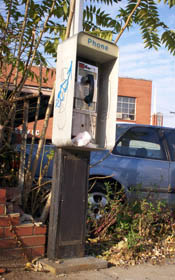 |
|
|
Politics
Main Page |
|
As Pay Phones Vanish, Homeless Find Other Ways to Stay Connected
Maryland Newsline Thursday, Nov. 29, 2007 WASHINGTON - One of the worst parts of being homeless is the loneliness, said David Pirtle, who has slept many nights on Baltimore’s waterfront and on Washington’s filthy streets. To combat feelings of isolation when he was homeless for more than two years, Pirtle would steal quarters people threw into a fountain at the National Museum of African Art on the National Mall. He would drop the money into a pay phone to talk to his parents and siblings in Ohio. In the last year, Pirtle found a home through a government program and acquired a cell phone. But those pay phones he once relied on to connect with the world are becoming increasingly harder to find for others who are less fortunate. Many homeless must look for alternative ways of communicating, such as cell phones and e-mail. They’re using them to connect not only with family, but with potential employers for work, government offices for assistance and others. “Everyone who’s in the middle class thinks, 'Oh, no one uses pay phones anymore.' But not everyone is in the middle class,” said Tracey Timpanaro, publisher of the monthly magazine of the American Public Communications Council, a national trade association for pay phone service providers.
The numbers echo what’s happening nationwide: The number of pay phones across the country shrank from about 1.9 million to about 1 million during the same time, FCC data shows. And most of those that remain look a little different than in the old days; just a handful of pay phones in the entire Northeast have booths around them, Verizon spokeswoman Christy Reap said. Much of the reason pay phones are dying is that so many people have cell phones, said Mason Harris, president of the Atlantic Payphone Association. The number of wireless telephone subscribers almost doubled between 2001 and 2006: from about 114 million to about 217.4 million, according to the FCC. Pay phones are eking out smaller revenues, and pay phone providers, like the ones Harris’ organization represents, are struggling to make a profit. When they don’t, pay phones are shut down. “Unfortunately, I do think that the numbers are going to continue to decrease,” said Harris, who is also the president of Robin Technologies in Rockville. Shelter Phones and Cell Phones The homeless do have other options, including phones many shelters let their residents use for free. But that can be a problem when someone is looking for work, because the person answering the phone will announce that the number belongs to a shelter, said Pirtle, 33.“The prospective employer is just going to hang up the phone. They’re not going to leave a message,” he said. Another problem is that people staying in a shelter often have to share one phone with dozens of others. The 50 men and women, but mostly men, at Community Vision's overnight shelter in downtown Silver Spring must sign up for a turn to use the phone, said facility manager Shena McFadden. She estimates about 20 people at the shelter have cell phones. But even they use the shelter phone when they can, she said. They need to save their expensive minutes. Most homeless people who have cell phones have pay-as-you-go plans for them, not contract plans, said Michael Stoops, the acting executive director of the National Coalition for the Homeless. They often don’t have the credit history or the identification they need to get more than a pay-as-you-go plan, he said. “I have some homeless friends who have cell phones, which is really a great equalizer,” Stoops said. “You can hide your homelessness status by having a voice mail account or a cell phone or an e-mail address, and no one knows that you’re living in a doorway in downtown Baltimore or downtown Washington.” Pirtle, who now works as a speaker for Stoops’ organization, has had a shiny, black cell phone since summer. He uses a pay-as-you-go plan. Such plans tend to cost more per minute. For example, Verizon Wireless customers who sign a two-year contract can get 450 minutes a month for $39.99 monthly, said Sherri Cunningham, a company spokeswoman. The cost works out to less than 1 cent per minute. Pay-as-you-go customers pay between 2 cents and 10 cents a minute, plus an access fee of 99 cents to $2.99 each day they use their phone, she said. Homeless people who can’t afford cell phones sometimes pay homeless people who do own phones to use them, said Eric Sheptock of Washington, who has been homeless for most of the last 14 years. He owns a cell phone, which Pirtle gave him after the two helped start the Washington nonprofit Until We're Home, Sheptock said. But the phone’s been turned off for six months, because Sheptock can’t afford to pay for it, he said. He usually heads to the nearest Metro station to find a pay phone when he needs to make a call. “It is important to note that homeless people who don't use the phone much throughout most of the year will want to use it at this time of year to call many family members and relatives,” he wrote in an e-mail Thanksgiving week. The Internet and Voice Mail E-mail is the way Sheptock, 38, communicates most of the time. He spends about three hours at a time, four to six days a week, reading and sending them from the computer terminals at public libraries, he said. Some shelters also offer Internet access. At Community Vision, residents looking for work can sign up for a turn using one of the shelter’s seven computers, McFadden, the facility manager, said. As much time as Sheptock spends online, he didn’t know about free software, such as Skype, which lets users make calls over the Internet for free. “I only learned to do e-mail a year ago this month,” he wrote. He didn’t know about Community Voice Mail, either. The national program provides free voice mail boxes to “people without phones seeking jobs, housing, healthcare or safety,” according to the Web site for the Washington affiliate. Clients record a personal greeting, then receive a code for checking their messages and a phone number to give out. They can’t make any calls from their number, but callers won’t hear that a phone is out of service or that a person lives in a shelter. Stacy Holmes, program director in Community Voice Mail’s national headquarters, said she’s heard from clients who have had to find alternative ways for checking their voice mail because pay phones are either scarce or not working. Early in the days of the organization, which began in Seattle and went national in 1993, one of the goals was to partner with pay phone providers so clients could check messages from pay phones for free, Holmes said. Today, those partnerships are happening in only a few cities, she said. Baltimore doesn’t offer Community Voice Mail, but it could one day, Holmes said. Community Voice Mail offers money and help for established social organizations willing to host the program. “We’ve heard time and time again from our clients it helps them break out of that sense of isolation,” Holmes said. Pirtle, who lost touch with his family for a while when he was homeless, agreed. The sense of not having any connection to the world was more than disheartening, it was discouraging, he said. “It’s one more barrier to getting yourself off the streets,” he said. Raechal Leone can be reached at raechal.leone@gmail.com. Copyright © 2007 University of Maryland Philip Merrill College of Journalism Banner graphic by Hortense Barber and Diego Mantilla. Banner photos of homeless person's cart and homeless man sitting are courtesy of Greg Sileo.
|


